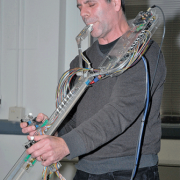|
At first glance, UUPer José “Tomas” Henriques’ double controller looks like a cross between some kind of bizarre metal detector and something “Star Wars” hero Luke Skywalker might use to fight the Galactic Empire. But the futuristic-looking apparatus doesn’t blast Imperial Stormtroopers or locate buried treasure—although it did end up making some cash for the Buffalo State assistant professor. The double controller, invented by Henriques, is a musical instrument, and a rather unique one at that. It was a hit at Georgia Tech’s prestigious 2010 Margaret Guthman New Musical Instrument Competition, held in Atlanta in March. Henriques’ creation—an electric, trombone-style instrument that produces sound by sliding and twisting two hand controllers on either side of its aluminum frame—took top honors in the event, beating out 26 entries from six countries. He won a $10,000 award for placing first. You can see his Guthman performance online at www.youtube.com/watch?v=0sX4Dleqz_0. “I envisioned it as an instrument with a unique sound, but not something too complex to have a personality,” Henriques said. Measuring nearly two feet long, the double controller produces a majestic, metallic and almost orchestral sound that’s both soothing and unsettling at times. The instrument has a musical range comparable to a piano; it can hit very low and very high notes. Made of Plexiglas, aluminum and circuitry, the double controller rests on the shoulder and works a little like a trombone. That’s not so surprising when you consider that Henriques, a composer, is an accomplished slide trombonist. But instead of one slide, there are two, which glide on thin rods on each side of the instrument; the slides help shape its resonant sound. The controllers are outfitted with a small joystick and 13 buttons. They also move, allowing Henriques to add vibrato and extend the notes he plays. Sound is created when Henriques blows into a mouthpiece attached to the instrument. But it’s the pressure of the air—not the air itself—that makes the sound. “The air goes to an air pressure sensor,” he said. “The sensor senses if air is being blown hard or soft and that’s used to control volume and how dull or bright the sound is.” The instrument’s brain is connected to a computer that analyzes and processes the data from the mouthpiece sensors. The computer instantaneously converts the data into sound, which can be manipulated by Henriques. “Because the sounds are all electric, you can make it sound like anything you want,” he explained. “That’s the beauty of it. I can make it sound like a flute or even someone speaking if I want to.” Henriques built the double controller last year, but he’s already planning modifications, like a version with a built-in amplifier and speaker. He may already have a taker. The principal trombone player for the Buffalo Philharmonic Orchestra has asked Henriques to build him a double controller. And several Buffalo area jazz players that have heard the instrument have given their thumbs up. “I’m planning on performing with it, but I’m not proficient right now,” Henriques said. “I’ve spent my time perfecting the software, so I’ve had little time to actually learn the instrument.” — Michael Lisi |
Member spotlight: Buff State UUPer makes his own kind of music
Reply


